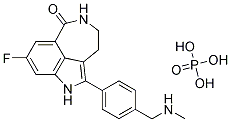
AG-014699 (PF-01367338, Rucaparib) is a PARP inhibitor with a Ki of 1.4 nM. AG-014699 is the phosphate salt of AG 014447 (CAS 283173-50-2) and has improved aqueous solubility. Poly (ADP-ribose) polymerases (PARPs) are activated by DNA single- and double-strand breaks and promote repair of DNA damage through the relaxation of chromatin and recruitment of other repair proteins. AG-014699 inactivates PARP activity in cells with homologous recombination DNA repair pathway mutations at LC50 values ranging from 1.3-5.5 μM. Radio-sensitization by AG-014699 is due to downstream inhibition of NF-κB activation, and independent of SSB repair inhibition. Although AG014699 can enhance response to some chemotherapeutic drugs via improved delivery, this does not apply to doxorubicin. PARP inhibitors may still be of use to counter doxorubicin toxicity.
| Cell Experiment | |
|---|---|
| Cell lines | LoVo and SW620 cells |
| Preparation method | We estimated cell growth inhibition in exponentially growing LoVo and SW620 cells in 96-well plates exposed to increasing concentrations of single-agent PARP inhibitor, temozolomide or topotecan, or combinations of temozolomide or topotecan with PARP inhibitor for 5 days before staining with sulforhodamine B as described previously (18). Cell growth, determined after subtraction of time 0 values, was expressed as a percentage of the relevant DMSO, cytotoxic drug, or PARP inhibitor alone control, as appropriate. GI50 (concentration of drug that inhibited growth by 50%) values were calculated from the computer-generated curves (GraphPad Software, Inc. San Diego CA). |
| Concentrations | 0~1000µM |
| Incubation time | 5 days |
| Animal Experiment | |
|---|---|
| Animal models | SW620 tumor xenografts |
| Formulation | saline |
| Dosages | 0.1, 1, 10mg/kg |
| Administration | oral |
| Molecular Weight | 421.36 |
| Formula | C19H18FN3O.H3PO4 |
| CAS Number | 459868-92-9 |
| Solubility (25°C) | DMSO ≥30 mg/mL |
| Storage |
Powder -20°C 3 years ; 4°C 2 years In solvent -80°C 6 months ; -20°C 1 month |
| Species | Mouse | Rat | Rabbit | Guinea pig | Hamster | Dog |
| Weight (kg) | 0.02 | 0.15 | 1.8 | 0.4 | 0.08 | 10 |
| Body Surface Area (m2) | 0.007 | 0.025 | 0.15 | 0.05 | 0.02 | 0.5 |
| Km factor | 3 | 6 | 12 | 8 | 5 | 20 |
| Animal A (mg/kg) = Animal B (mg/kg) multiplied by | Animal B Km |
| Animal A Km |
For example, to modify the dose of Compound A used for a mouse (20 mg/kg) to a dose based on the BSA for a rat, multiply 20 mg/kg by the Km factor for a mouse and then divide by the Km factor for a rat. This calculation results in a rat equivalent dose for Compound A of 10 mg/kg.
[3] Hunter et al. Oncogene. NF-κB mediates radio-sensitization by the PARP-1 inhibitor, AG-014699.
| Related PARP Products |
|---|
| DSB-1522
DSB-1522 is a PARP1 inhibitor that can be used in tumor-related studies. |
| DM-5167
DM-5167 is a PARP1 inhibitor that can be used in studies related to triple negative breast cancer. |
| NMS-03305293
NMS-03305293 is a PARP inhibitor with high selectivity for PARP1 isoforms and low DNA capture effect, which specifically kills BRCA mutated tumor cells. In addition, NMS-03305293 can penetrate the blood-brain barrier and can be used in studies related to CNS tumors and brain metastatic tumors. |
| SNV1521
SNV1521 is a potential best-in-class (BIC), highly selective and CNS-permeable PARP1 inhibitor. |
| Basroparib
Basroparib is an orally active selective inhibitor of end-anchor polymerase (TNKS) and an inhibitor of ribose polymerase (PARP) with antitumor activity. |


Products are for research use only. Not for human use. We do not sell to patients.
© Copyright 2010-2023 AbMole BioScience. All Rights Reserved.
